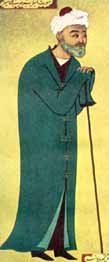SHARE WITH FRIENDS:
1. When and where was Alisher Navoi, the great figure of world spirituality of the XNUMXth century, born and what was his real full name?
His real name is Nizomiddin Mir Alisher. He was born on February 1441, 9, in Herat, where he spent most of his life.
2. Who were Alisher Navoi's first teachers of poetry? In which of his works did he give information about these teachers?
Navoi's first teachers of poetry were his uncles Mir Sayyid Kabuli and Muhammad Ali Gharibi. In Majlis un-nafois, Navoi says of Kabuli: "He had a good temperament, he preferred Turkish." He said of Gharibi: "He was a good talker and a kind and gentle young man. He could play more words better. He and his method were good. He was also aware of the science of music. ”
3. To whom was the poet's poem "Hilaliya" dedicated, and when and by whom was the title "Amir Kabir" or "Great Amir" given to him?
The poet's poem "Hilaliya" is dedicated to the Timurid ruler Hussein Boykaro. In February 1472, Hussein appointed Boykaroga as a minister and gave him the title of "Amir Kabir" ("Great Amir").
4. What was the name of the madrasah built for students in Herat during the Navoi period?
During the Navoi period, a madrasah called Ikhlosiya was built for students in Herat.
5. Mawlana Lutfi t wants to replace a twelve thousand byte poem written in Urki and Persian?
wants to replace a twelve thousand byte poem written in Urki and Persian?
Mevlana Lutfi wrote twelve thousand bytes of poems in Turkish and Persian, beginning with Navoi's ghazal, "Orazin is closed from my closed eyes, every moment is young, tall, a star appears, the sun is shining." will try to replace the rin.
6. In what year did Alisher Navoi complete his great work "Khamsa" and how many epics does this work contain? How many thousand lines of poetry does this artistic encyclopedia contain?
In 1483, Alisher Navoi began to write his great work "Khamsa" and completed it in three years. This encyclopedic encyclopedia of five epics contains more than 50 verses, making up almost half of Navoi's entire poetic heritage.
7. Who glorified Navoi as "Mir Nizamiddin" and what does this name mean?
The Samarkand statesman praised Alisher Navoi as "Mir Nizamiddin", ie "the law of religion is the law".
8. When and by whom was the first "Khamsa" in Persian created?
The first "Khamsa" in Persian was created by the great poet Nizami Ganjavi (1141-1209).
9. What do you know about the history of the establishment of the college "Khazaynu-l-maoniy"? What can we conclude from the fact that the poems in Khazaynu-l-maoniy are arranged in a precise mathematical order?
In 1492, the pamphlet Mezon ul-avzon (Weight of Weights) was written, and the poet redistributed his lyrical work and published a new collection of devons, Khazayn ul-Maoniy (Treasure of Meanings). began to work hard to create. Known as the "Chor Devon", this large collection includes about 45 lines of small and medium-sized poems of various genres, "Wonderful Cow" ("Wonders of Childhood"). , "Navodir ush-shabab" ("Rareness of youth"), "Badoe'ul-vasat" ("Discoveries of the Middle Ages"), "Favoyid ul-kibor" ("Useful considerations in old age"). These four volumes contain more than 16 poems in 3000 genres, including 2600 ghazals, 210 continents, 133 rubais, 86 fards, 52 problems, and more. Khazayn ul-Maoniy included almost all the poems from the previous two separate divans, and then added about 1400 new works.
10. Navoi created three great works in 1498, 1499 and 1500, and these works were the culmination of the poet's and thinker's work. What were these works?
In 1498, Navoi wrote Lison ut-tayr, in 1499 Muhokamat ul-lughatayn, and in 1500 Mahbub ul-qulub. These three works were the culmination of the work of the great poet and thinker.
11. What are the five epics that contain "Khamsa" and in what years were they created?
Navoi began to create his "Khamsa" in 1483, and finished his first epic "Hayrat ul-abror" ("Surprise of good people") in the same year. In 1484 he completed the epic "Farhod and Shirin", "Layli and Majnun", "Sab'ai Sayyar" ("Seven Planets"), and in 1485 "Saddi Iskandariy".
12. What is the meaning of the poet's nickname "Navoi"? What is his second nickname and what does it mean?
"Navoi" is a nickname of the poet, and the word navo means "melody", "happiness", "singing", "happiness". The poet got his nickname from the word "bahra". He said the following about it:
In the garden of Dahr,
Komronlar found nazmimdin navo.
The second nickname of the poet is also associated with such meanings. The Qur'an states that this world is a transitory, created world for testing. That is why the poet chose the nickname "Foniy". The poet himself wrote about this:
When Fayz arrived, he said,
Found a character in the background of the poem.
13. When and by whom was the first source of information about Navoi written, and what was the name of that work?
The first source of information about the life and work of Alisher Navoi is undoubtedly the works of the great poet. Abdurazzaq Samarkandi's work "Matla'i sadayn wa majmai bahrayn" ("Origin of two happy planets and the confluence of rivers") is the first source of information about the poet. This work was created between 1467-1470.
14. Who created the first tazkira named after Alisher Navoi and what was it called?
The work of the Samarkand state "Tazkiratu-sh-shuaro" ("Poets' tazkirasi") is the first tazkira named after Alisher Navoi.
15. Which work did Navoi write under the influence of the Qur'an, and who is it about?
Influenced by the Qur'an, Navoi wrote "History of the Prophet and the Ruler." This work consists of two parts, the first of which gives information about Adam, Noah, Jesus, James, Solomon, Joseph, David and other prophets. At the end of each story, a rubai is given and an introduction is made.
